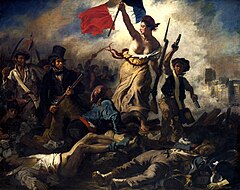1830 July Revolution
| Part of Bourbon Restoration | |

Liberty Leading the People by Eugène Delacroix: an allegorical painting of the July Revolution.
|
|
| Date | 26–29 July 1830 |
|---|---|
| Location | France |
| Also known as | The July Revolution |
| Participants | French society |
| Outcome | Abdication of Charles X Ascension of Louis Philippe to the French throne and establishment of the constitutional July Monarchy |
The French Revolution of 1830, also known as the July Revolution (révolution de Juillet), Third French Revolution or Trois Glorieuses in French ("Three Glorious [Days]"), led to the overthrow of King Charles X, the French Bourbon monarch, and the ascent of his cousin Louis Philippe, Duke of Orléans, who himself, after 18 precarious years on the throne, would be overthrown in 1848. It marked the shift from one constitutional monarchy, under the restored House of Bourbon, to another, the July Monarchy; the transition of power from the House of Bourbon to its cadet branch, the House of Orléans; and the replacement of the principle of hereditary right by popular sovereignty. Supporters of the Bourbon would be called Legitimists, and supporters of Louis Philippe Orléanists.
Upon Napoleon's abdication in 1814, continental Europe, and France in particular, was in a state of disarray. The Congress of Vienna met to redraw the continent's political map. Many European countries attended the Congress, but decision-making was controlled by four major powers: the United Kingdom, represented by its Foreign Secretary Viscount Castlereagh; the Austrian Empire, represented by the Chief Minister Fürst Metternich; Russia, represented by Emperor Alexander I; and Prussia, represented by King Frederick William III.
...
Wikipedia
